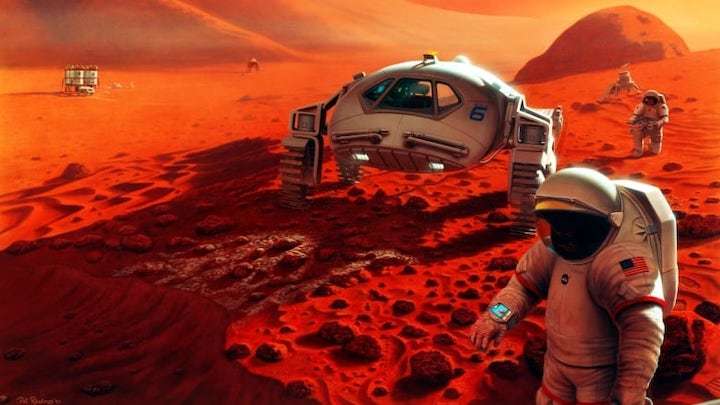7.01.2021
As 3 space missions prepare to land on Mars next month, a Canadian reflects on Mars One's stalled plans

No human has visited Mars, but artists have imagined what life would look like on the Red Planet. (Pat Rawlings/SAIC/NASA)
In another world, Tyler Reyno is in the final stages of ending his Earthling life to begin a new one as a Martian.
Seven years ago, the Nova Scotian was selected to join the Mars One mission to establish humanity's first interplanetary civilization.
He signed up for the one-way trip to Mars in a burst of optimism.
"I wanted to hope that it might be true. I think that in the moment, I figured that if companies like Space X and Blue Origin could make the technological steps they were making, then it made sense that other companies could do the same," he said.
"Unfortunately, it did prove to be infeasible. Basically their concept, the resources, the funding, the overall goals — all of it was a little too unrealistic."
Instead of travelling 55 million kilometres through space, he moved a mere 4,500 kilometres across land to work in British Columbia.
He compares the enthusiasm and widespread media coverage of private space companies from 2010 to 2015 to the tech bubble of the early 2000s. In the tech bubble, no one knew which companies would be Facebooks and which would be Friendsters — the now-defunct social networking service.
Reyno said it was the same with companies like Space X and Mars One.

"Mars One capitalized on a very ripe time of optimism within the private space sector," he told CBC News this week. "It was really eye-opening for a lot of people. I think it set the bar too high on what the private sector can do."
Reyno got an email telling him he was off the spaceship a few years ago. Mars One was reported to have entered bankruptcy in 2019 and some candidates have said there was never any chance it would have gone to Mars.
But CBC News did speak to two Canadians who are still listed on the mission, and still expect to stand on Mars one day. No Nova Scotians remain connected to the project.
Ben Criger holds a PhD from the Institute for Quantum Computing in Waterloo, Ont., and has given TedX talks on the Mars mission.
"I am still involved with Mars One, and in touch with both (CEO) Bas Lansdorp and the other candidates," he said in an email.
"Bas sends us regular updates, but they're confidential, so you'd have to go directly to Mars One for a more comprehensive update."

Karen Cumming, a Ontario journalist and teacher, said she also remains on the Mars One team.
"The last communication I had from the Mars One CEO, Bas Lansdorp, was in October of last year," she said. "We're not at liberty to discuss anything concerning the mission."
CBC News asked Mars One and Lansdorp for an interview, but didn't hear back.
In 2014, the private company said training would take up to a decade. The first humans were supposed to depart Earth in 2024 and start the extraordinary colony in 2025.
The website still says candidates are "expected" to start training three years ago and would be living and training together full time until 2031, when they would leave Earth for Mars.

The company's last news release was issued 2½ years ago and it last posted on social media nearly two years ago.
The website does not show any actual spacecraft, but it does have many vivid illustrations of the Mars mission.
Reyno said the experience has not jaded his lifelong love of space exploration. He went on to earn a master's degree in aeronautical engineering and today works as an aerospace engineer for ASCO Aerospace in Vancouver, working on projects for Lockheed Martin, Boeing and Bombardier.
He mostly works on Earth-bound aircraft these days. "But I still do keep a keen eye on a lot of space technology and space progress. The goal is still to further myself in that area," he said.
He said others should keep their eyes on the bright red dot in the sky, so close that humans have been able to see it for as long as we've walked the Earth, inspiring dreams of alien civilizations.
In 2020, three separate missions launched for Mars and all of them are due to arrive next month. No humans are on board, but with new space nations like China and the United Arab Emirates now involved alongside stalwarts like the U.S., Reyno sees reasons to hope the dream of life on Mars is not dead.

"I'm more optimistic than ever. That was one small instance of a project that wasn't successful, but at least they tried," he said. "Mars One probably was unrealistic and shot too high, but from all this optimism, so many really good and successful projects have continued to grow."
His life has continued to grow, too, and he's not sure if he would take the big trip to the sky if it was offered to him.
"I do have more ties to Earth now. I have a girlfriend, a partner that I've been with for 4½ years, varying goals here now and a lot of different things I'm passionate about here," he said.
"Mars and space exploration are probably my greatest passion and I do feel so much desire to be involved in space exploration. It would be harder than ever to make a decision like that."
Quelle: CBC

